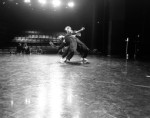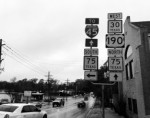
Crazy Wood and Bare Feet
by Jennifer Passios
Huntsville, TX
On a hot August night, my friend Ti let me in on a secret. I opened my Instagram feed to see them dancing alone under the glow of multi-colored can lights in a huge, wood floored room with steel siding, a 20-foot high ceiling, and a bright yellow door in the background. I was stunned. Ti doesn’t drive which means that this immaculate dance space had to exist within walking distance of the place they were renting. Like me, Ti had been trying to find their path dancing in Huntsville -- a tall order in prison town USA, seventy miles from the nearest city. I messaged them right away.
“WHERE IS THIS?!”
They answered back almost immediately.
“The Barefoot Ballroom. Let me show you.”
I met Ti at their place -- a temporary rental at the end of a line of whimsically kitschy Air Bnbs set to look like surf huts. Ti was in between leases and had fallen in luck when they rented from Smither Company Real Estate. When Ti was signing their rental agreement, they met directly with Real Estate Broker John Kerr Smither. Loquacious, curious, and relentlessly productive, John is not only a local housing mogul, but also a trained sculptor who, fortunately for Ti and me, also happens to love dance.
The Smither family set roots in Huntsville in 1839 and quickly made a lasting mark on the town. This influence remains today, the names of various family members peppering businesses and landmarks throughout the community. On any given day, one may walk by Smither Park, cruise down Smither Drive, or stay at one of the many properties in the downtown cultural district managed by Smither Company Real Estate. Community members may seek legal advice at Smither, Martin, & Henderson P.C. and students in the Sam Houston State University art department have the chance to advance their studies through the Smither Family Art Endowed Scholarship.
Ti walked me over to Smither Company Real Estate, an unassuming looking commercial building on Sam Houston Avenue. I had passed this business hundreds of times on walks downtown or as I approached the turnaround point on one of my go-to run routes. There had never been a reason to pay the building much mind, aside from the marquee outside which often proselytized strange things like “OPTIMISM! NOT OPPOSOMISM!”
We approached a side door. Ti punched in a door code. The alarm made a reassuring beep, ensuring us we would not get arrested for dancing in a real estate building. We walked in. Ti turned on the light, and I stood still momentarily flabbergasted by the vast expanse of smooth wood floor beneath my feet.
Originally named “Crazy Wood” for the preservation technique used to decorate and fortify the facility’s walls, The Barefoot Ballroom occupies 4000 sq. feet of what was once the Sam Houston State University Campus Cleaners. John and his first wife Amanda began converting the steel building into a dance oasis seventeen years ago. The pair worked together to install a 40’x50’ sprung maple dance floor, lighting options, and a small sound board. For five years, they co-raised their son on the property which, in addition to the dance floor, also boasts a sauna, shower, and cold plunge.
Ti and I galavanted for about an hour, sweating profusely in the August heat (despite its many amenities, the Barefoot Ballroom does not yet have temperature control). I felt high from the dehydration and magic of finally having a space to dance that wasn’t my own living room. My mind raced with all of the dancing that might happen on this floor that was apparently lying dormant most days. I needed to meet John.
At age 62, John approaches his work and life with the enthusiastic, hands-on attitude of an early explorer. We’ve sat down together for meetings a number of times since Ti first introduced us. Without fail, John strides through the door, polished walking stick in hand, clad in an aesthetic best identified as Texan Indiana Jones. Today’s ensemble features an olive colored felt hat, a pair of black hiking pants with a prominent buckle, and a Mountain Hardwear half-zip pullover with a mesh long sleeve peeking out from under the zipper.
He unscrews his thermos -- a mix of matcha and lion’s mane -- and pulls up a chair to share his future plans for the Ballroom. He picks up a large binder and places it on the table between us. Inside, John has meticulously collected and organized all of the paper media from every event he has hosted at the Ballroom. His blue eyes widen with excitement. “I had this idea of a Huntsville Dance Village,” he reveals while flipping to a program of an event from the early 2010s. “I wanted to set this up right where I live. Huntsville is a beautiful little downtown.”
John views dance as a therapeutic modality. He speaks with enthusiasm about ecstatic movement, Gabriel Roth’s 5Rhythms, and contact improvisation. Since its inception, the Barefoot Ballroom has been intended as a space for workshops. A product of the self-development workshop era, John holds a deep interest in movement as a mode of exploring emotional and physical confrontation. He views dance as a central pillar within those investigations.
According to John, Barefoot Ballroom workshops regularly pulled in 50-90 attendees from Houston, Dallas, Ft. Worth, and San Antonio during its first decade of operations. I initially assumed those numbers must have been exaggerated. Having been involved in multiple modes of dance for most of my life, I’ve regularly listened to presenters and curators gripe about lack of attendance at participatory dance events even in large cities. Teaching at one of John’s workshops two years ago suggested otherwise.
John closed the Ballroom to the public prior to the pandemic, during the period when he and Amanda were raising their son on the property. The facility remained shut, collecting dust, until 2022 when John held a fall Movement Marathon. When he first approached me and my partner Jacob to teach and explained his programming plan, which involved capping attendance at 100 participants over the course of the day long event, I thought he was nuts. Jacob and I were thrilled to teach a group of what we figured would be at max 10 people if we invited our students along, and if they showed up. We arrived for our contact improvisation class on a 40 degree day in November featuring a light coating of freezing rain. Over 30 people showed up for our class. Another 30 or so dance enthusiasts from within a 200 mile radius of Huntsville trickled in over the course of the day. Even after a half decade closure, Texans from all around the region showed up en masse to dance.
John understands marketing and knows the type of people who will drive to Huntsville on a cold rainy day. While the crowd we encountered at the Movement Marathon was quite different from those I typically see in the professional contemporary dance world -- picture full grown adults in animal onesies, a woman yelling “WOOO, Wooohoo” and bobbing her head around for the entirety of the class, and the man walking around unabashedly in his underwear after using the sauna -- the group did demonstrate a clear interest in the act of dancing and an excitement about the possibility of dance as a tool for liberation and self-actualization. John has continued catering to this New-Agey audience, recently adding a pulldown menu tab titled “Yonga” to his website. He defines this self coined term as “both the dance and its core essence, defined by the concept of unity through partnership.”
The turnout at the Movement Marathon, and the continued revamp of the Ballroom in the wake of the pandemic, both stand as testaments to John’s entrepreneurial knowhow and financial resourcing, which he leverages wisely in tandem with his family’s influence and old money status. When asked about challenges for others hoping to open dance spaces for adults outside of major metropolitan areas, John acknowledges, “I’m in the real estate business. Your jaw would drop if you knew how inexpensive this place was when I bought it. Maintenance, labor, and construction would probably hurt most people now.”
I ask John about his vision for the future of the Ballroom. His eyes gleam as he launches into an idea about visiting the local farmer’s market on Saturday mornings and inviting the community to “Open Space Days” – which include a discussion or showing with a local arts practitioner followed by two hours of dancing – at the Ballroom immediately after the market.
“Imagine, telling people about what we do at the Ballroom and then inviting them to participate immediately afterward. The best way to understand dance is to experience it.”
He muses aloud, “Instead of being consumers of that culture in Houston, what if we could produce it here?”
The Barefoot Ballroom is the second installment in a multi-part series exploring the ability to access dance outside of major metropolitan areas. Click here for Part 1: Out of Range.
By Jennifer Passios
February 23, 2024









